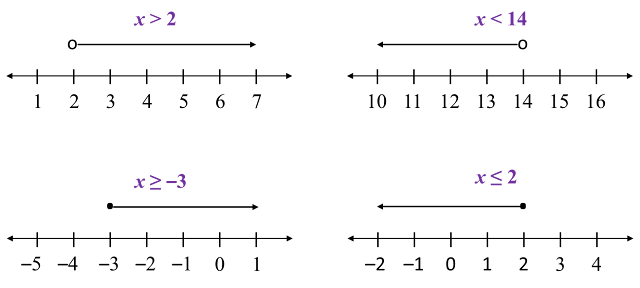12.1 Linear Inequalities
12.1.1 Inequalities
1. To write the relationship between two quantities which are not equal, we use the following inequality signs:
> greater than
< less than
≥ greater than or equal to
≤ less than or equal to
2. 7 > 4 also means 4 < 7. 7 > 4 and 4 < 7 are equivalent inequalities.
12.1.2 Linear Inequalities in One Unknown
1. An inequality in one unknown to the power of 1 is called a linear inequality.
Example: 2x + 5 > 7
2. A linear inequality can be represented on a number line.
12.1.3 Computation on Inequalities
1. When a number is added or subtracted from both sides of an inequality, the condition of the inequality is unchanged.
Example:
Given 5 > 3
Then, 5 + 2 > 3 + 2 ← (symbol ‘>’ remains)
Hence, 7 > 5
2. When both sides of an inequality are multiplied or divided by the same positive number, the condition of the inequality is unchanged.
Example:
Given 4x ≤ 16
Then, 4x ÷ 4 ≤ 16 ÷ 4 ← (symbol ‘≤’ remains)
Hence, x ≤ 4
3. When both sides of an inequality are multiplied or divided by the same negative number, the inequality is reversed.
Example:
Given –3 > –5
Hence, 3 < 5
Given –5y > –10
Then, –5y ÷ 5 > –10 ÷ 5
–y > –2
Hence, y < 2
12.1.4 Solve Inequalities in One Variable
To solve linear inequalities in one variable, use inverse operation to make the variable as the subject of the inequality.
Example:
Solve the following linear inequalities.
Solution:
(a)
(b)
(b)
12.1.5 Simultaneous Linear Inequalities in One Variable
1. The common values of two simultaneous inequalities are values which satisfy both linear inequalities.
The common values of the simultaneous linear inequalities x ≤ 3 and x > –1 is –1 < x ≤ 3.
2. To solve two simultaneous linear inequalities is to find a single equivalent inequality which satisfies both inequalities.

